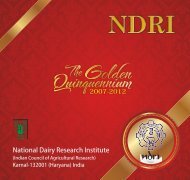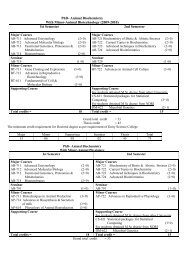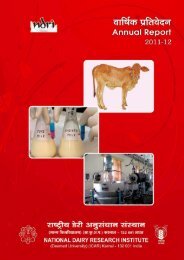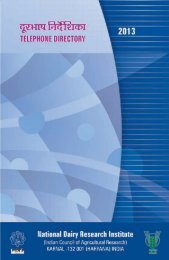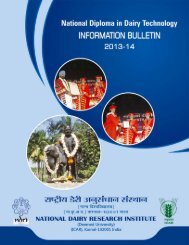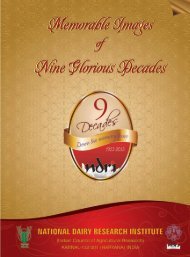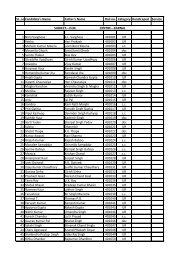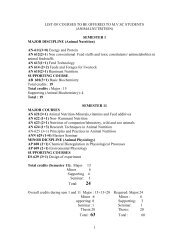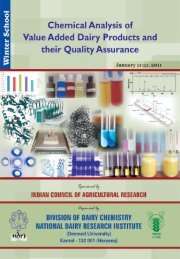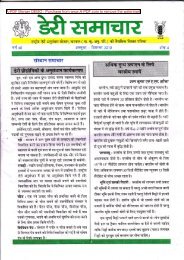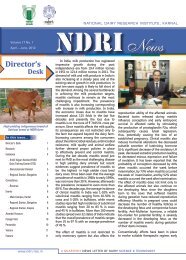ANIMAL BIOTECHNOLOGY Course Structure – at a Glance for M.Sc ...
ANIMAL BIOTECHNOLOGY Course Structure – at a Glance for M.Sc ...
ANIMAL BIOTECHNOLOGY Course Structure – at a Glance for M.Sc ...
Create successful ePaper yourself
Turn your PDF publications into a flip-book with our unique Google optimized e-Paper software.
<strong>Course</strong> Contents<br />
<strong>ANIMAL</strong> <strong>BIOTECHNOLOGY</strong><br />
First Semester M.<strong>Sc</strong>./ M. V. <strong>Sc</strong>.<br />
BT 611 FUNDAMENTALS OF CELL & MOLECULAR BIOLOGY 3+0<br />
Objective: Molecular structure and functions of cells and molecules such as DNA, RNA<br />
and proteins.<br />
Theory<br />
UNIT I<br />
Evolution of cells, Introduction to molecular interactions, thermodynamics, and<br />
equilibrium in molecular recognition and biological functions. Cellular compartments<br />
and intercellular sorting of proteins: endoplasmic reticulum, lysosome, peroxisomes,<br />
synthesis and sorting of proteins (lysosomal proteins, membrane proteins, secretary<br />
proteins, lipoproteins, glycolipids. Lipid synthesis and transport.<br />
UNIT II<br />
Cell signaling: Endocrine, exocrine and synaptic signalling molecules, surface and<br />
intracellular receptors, G proteins and gener<strong>at</strong>ion of secondary messengers, mode of<br />
action of cAMP and Ca++ calmodulin, target cell adapt<strong>at</strong>ion. Cell growth and divisions:<br />
Cell cycle, cell division controls and trans<strong>for</strong>m<strong>at</strong>ion, growth factors, genes <strong>for</strong> social<br />
control of cell division, mechanism of cell division, cell adhesion, cell junctions and the<br />
extra cellular m<strong>at</strong>rix, growth, development and differenti<strong>at</strong>ion.<br />
UNIT III<br />
History of molecular biology, nucleic acid as hereditary m<strong>at</strong>erial, structure of DNA,<br />
chrom<strong>at</strong>in, rRNA, tRNA and mRNA, proteins. DNA replic<strong>at</strong>ion, transcription, transl<strong>at</strong>ion,<br />
genetic code, operon, positive and neg<strong>at</strong>ive control of gene expression.<br />
UNIT IV<br />
Molecular mechanism of mut<strong>at</strong>ion. Molecular organiz<strong>at</strong>ion of cell, structure of genomes.<br />
RNA processing and altern<strong>at</strong>ive splicing and molecular evolution, RNAi and applic<strong>at</strong>ion.<br />
Suggested Readings<br />
Lewin B. 2008. Gene IX. Jones & Bartlett.<br />
Primrose SB. 2001. Molecular Biotechnology. Panima.<br />
Twyman RM. 2003. Advanced Molecular Biology. Bios <strong>Sc</strong>ientific.<br />
BT 612 <strong>ANIMAL</strong> CELL CULTURE: PRINCIPLES AND APPLICATIONS 2+1<br />
Objective: Understanding the principles of animal cell culture and its applic<strong>at</strong>ion.<br />
Theory<br />
UNIT I<br />
Introduction, importance, history of cell culture development, different tissue culture<br />
techniques including primary and secondary culture, continuous cell lines, suspension<br />
culture, organ culture, hybridoma technology, culture of lymphocyte, oviductal, epithelial<br />
cell culture, stem cell and iPS cells.<br />
UNIT II<br />
Different type of cell culture media, growth supplements, serum free media, balanced<br />
salt solution, other cell culture reagents, culture of different tissues and its applic<strong>at</strong>ion.<br />
UNIT III<br />
2



